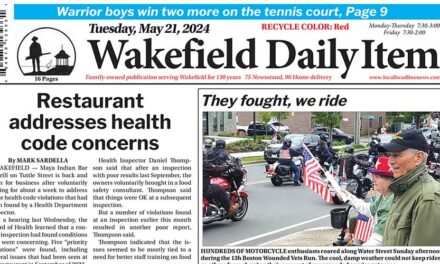By NEIL ZOLOT
WAKEFIELD – You can add Wakefield to the short list of communities that don’t like being told what to do by the state of Massachusetts when it comes to zoning.
Last night, Town Meeting rejected three proposals for a multi-family housing zone by right to comply with a state mandate in communities with or adjacent to public transportation. “We can’t absorb that in the zone,” neighborhood resident Jane McConnell argued during the opening 2024 session at the Galvin Middle School.
In 2020, the Massachusetts Zoning Act (Section 3A of Massachusetts General Laws Chapter 40A) was amended to promote the production of multi-family housing within walking distance of public transportation to address a “severe regional housing shortage.”
The new Zoning Act requires all MBTA communities, including Wakefield, to create at least one multi-family zoning district of reasonable size near public transit in which multi-family housing is permitted as of right. “As of right” means that a developer may proceed without obtaining a Special Permit, variance, zoning amendment, waiver, or other zoning approval. In the proposed district, the plan would allow up to four units in a three-story building with a height of up to 35 feet on a minimum lot size of 4,000 square feet.
Article 17, the Planning Board’s compliance plan, went beyond the state mandate, creating a larger-than-required district allowing more multifamily units than the state requires. The Planning Board has said that their plan addresses a housing shortage while creating more housing near the downtown commercial district, which they maintain will help local businesses.
Article 18 was an alternative, minimum compliance model, creating a much smaller district and allowing only a number of new multifamily units sufficient to meet the state requirements. Article 18 was the result of a citizens’ petition.
Both articles were taken out of order after the Fiscal 2025 town budget was approved last night. Article 17, the Planning Board proposal, called for a zone allowing 2,363 housing units. “It’s not necessarily what will be built,” Planning Board member and MBTA Working Group Chairman James Hogan explained. “This is for a zoning capacity change, not a building mandate. The state has mandated a need for new housing because prices have gone up. Multi-family housing already exists in the district.”
Lack of compliance by the end of the year could lead to a loss of state aid, as communities that have defied the mandate, like Milton, are finding out. Other communities are also defying the mandate and are planning collective legal action against the state.
“We’re not going to take it,” resident Robert McLaughlin feels. “We don’t have the capacity and need to tell the state we’re not interested in the program.”
After this and other pushback from the floor, Hogan submitted another map allowing only 1,805 units. “We had heard concerns with the size of the map,” he admitted. “On that basis, we developed an alternate map.”
The 1,805 units are above the minimum requirement of 1,696, but Hogan said state authorities suggested a 10 percent buffer of additional capacity to ensure compliance.
That led to accusations of a “bait and switch,” by resident Michelle McNall, among others. Town Councilor Michael McLane accused Hogan of “tossing this out at the last minute.”
The third alternative was Article 18, the citizens’ petition for 1,747 units introduced by Town Councilor Ed Dombroski. “Public comment seemed to be disregarded by the Planning Board and their proposal is far in excess of the minimum required,” he said. Dombroski’s worried the town will “put ourselves in a position of lost revenue in grants. If we get this on the books and the Supreme Judicial Court rules against the law, nothing prevents us from taking further action.
At times the various proposals bogged Town Meeting down in procedural difficulties and created some confusion about what was being voted on. Votes had to be taken on amending Hogan’s proposal with a new map, then on Article 17 with the new map, Article 18 and various motions to open and close debate and vote.
The move to use the 1,805 unit map was defeated on the basis it had not ben vetted. Resident Tom Miller said introduction of the 1,805 unit map “lacked transparency,” although Town Council chairman Jonathan Chines said the choices “crystalize the choices we have to make.”
Then, the original 2,363 unit map was rejected.
In debate on the 1,747 unit map Chines said he didn’t like that the zone was “pulled away from downtown to the West Side, but compliance or non-compliance is not an option. We stand to lose a lot of grant funds.”
McLaughlin and Finance Committee member Daniel Sherman questioned what additional units would cost the town in terms of public services, although Sherman admitted some of that would be recouped by new growth. “I encourage a positive vote, but I hope someone does a financial analysis,” Sherman said.
Nevertheless, the question was defeated 230-207.





